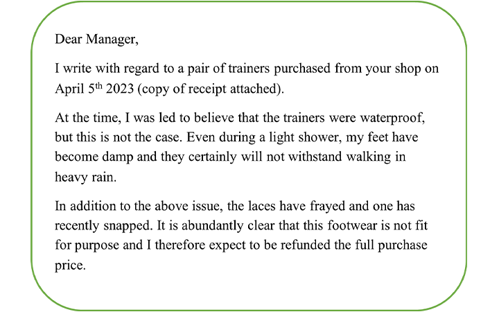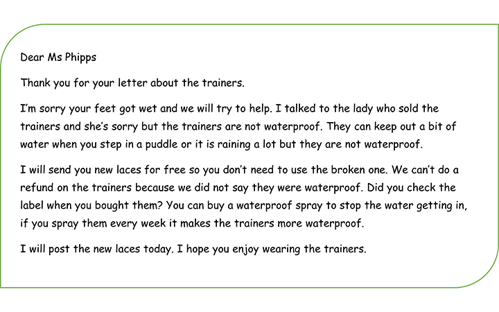Making accurate teacher assessment judgements about pupils’ writing
Making accurate teacher assessment judgements about pupils’ writing
There’s currently no national training for year 6 teachers on how to make judgements about their pupils’ writing using the TA Framework, and only those approved as local authority moderators actually go through the national standardisation process.
So we’re often asked how to identify the strengths in a pupil’s writing that contribute to an overall judgement at one of the three national standards: working towards the expected standard, working at the expected standard, and working at greater depth.
Obviously, when you make an overall judgement about a pupil’s writing, you’ll be looking at a broad range of evidence. That said, individual pieces of writing do contribute to that evidence base, and so help to build a picture of a pupil’s attainment.
Below is a writing stimulus (a formal letter of complaint to a shoe shop manager) followed by illustrative exemplification of three different responses to the stimulus. We’ve commented on each response to show how it might contribute to a judgement at each of the three standards.
Writing stimulus:

Illustrative Exemplar response 1: supporting a judgement of working towards the expected standard

So how does this piece support a judgement of working towards the expected standard?
Well, the purpose of the writing is clear – to respond to the complainant on behalf of the store management. And the vocabulary choices, whilst not particularly adventurous nor precise, do support the purpose too (feet got wet... the lady who sold the trainers...new laces for free).
Specific points are organised within paragraphs, and simple devices help structure the format of the letter, including a polite salutation and slightly informal sign off.
There are signs of experimentation with more ambitious grammatical structures, as in the use of both co-ordination and subordination in multi-clause sentences (They can keep out a bit of water when you step in a puddle or it is raining a lot but they are not waterproof), and the use of a relative clause to expand a noun phrase (the lady who sold the trainers).
And apart from a single comma splice, demarcation is correct, as are apostrophes for contraction.
But we can’t say that this piece supports a judgement of working at the expected standard.
Language choices really show only limited awareness of the reader.
What’s more, vocabulary and grammatical structures don’t reflect the appropriate level of formality (got wet... a bit of... raining a lot... don’t need... the broken one... can’t do... Best wishes), and the rhetorical question veers more towards accusation (Did you check the label when you bought them?) than the firm, but diplomatic, tone required.
Although the punctuation for this standard is secure, there’s no evidence of the wider range of punctuation taught at key stage 2. Indeed, where a more ambitious structure is attempted, a comma splice incorrectly separates the clauses (You can buy a waterproof spray to stop the water getting in, if you spray them every week it makes).
And whilst a degree of cohesion is achieved through pronoun referencing and subject-specific vocabulary, this tends to be weakened by repetition (I’m sorry... she’s sorry... about the trainers... the lady who sold the trainers... the trainers... waterproof... waterproof spray... water).
Illustrative Exemplar response 2: supporting a judgement of working at the expected standard

So how does this piece support a judgement of working at the expected standard?
In this piece, not only is the purpose of writing clear, but it’s also effective, with the balance of empathy and argument showing good awareness of the reader (I’m sorry to hear... so they must not be used... sales team always explain... we are surprised... we value you as a customer).
We can see how the writer draws on vocabulary and grammatical structures that reflect what the writing requires. For example, modal verbs express necessity (must not), possibility (could be the reason) and certainty (will start to wear out... will be less strong), whilst expanded noun phrases convey information concisely (a problem with the trainers you bought... Our expertly trained sales team).
What’s more, there’s a clear attempt to deliver the required level of formality, for example, through the use of the present perfect (have reported... would have been clear... have broken... have worn them) and passives (must not be used... are checked).
Verb tenses are consistent and correct, with appropriate shifts between past and present within sentences (you have a problem with the trainers you bought... it is 3 months since you bought them).
And various devices build cohesion between and within paragraphs, including pronoun referencing (I’m... You... we... they... them), determiners (Our... your), and subject-related vocabulary (a problem... reported... trainers... well-made shoes... customers... you as a customer).
A range of punctuation is used correctly, including commas for parenthesis (We sell a waterproof spray, which is cheap to buy, to help...) and to mark fronted subordinate clauses (If you have worn them for a long time, this could be... As it is 3 months since you bought them, they will be). There’s also a hyphen to avoid ambiguity (well-made shoes).
But we can’t say this piece supports a judgement of working at greater depth.
The writing doesn’t yet exercise an assured and conscious control over levels of formality.
At times, the writer draws on the more informal language of speech (I’m sorry... we can’t offer), and choices of grammar and vocabulary become less judicious, adopting a slightly combative tone (must not be used... cheap to buy... get it online... surprised... a long time... less strong), rather than a more conciliatory manner that might placate the recipient.
Illustrative Exemplar response 3: supporting a judgement of working at greater depth

So how does this piece support a judgement of working at greater depth?
In this piece, the writer uses their knowledge of grammatical structures to make judicious choices that distinguish between the language of speech and writing. For example, passive (is advertised... is clearly stated… were offered... were not sold) and perfect (have not met.... had specified… have become frayed... has snapped) forms, occasionally incorporating the modal ‘would’ (would have clarified… would have been suited) to emphasise certainty, convey a distinctly formal and resolute tone.
And choices of vocabulary are equally apt, demonstrating a strong awareness of the reader (purchased... expectations... stated... served... unaware... specified… clarified... option... guarantee... gesture).
An appropriate range of punctuation taught at key stage 2 is used correctly and effectively, including semi-colons and a colon to mark the boundary between independent clauses, commas for clarity, and a hyphen to avoid ambiguity.
Recognising the features of ‘greater depth’
We know it can be tricky to distinguish between writing that consistently meets all of the ‘pupil can’ statements for the expected standard, and writing that’s on the cusp of ‘greater depth’.
Central to greater depth is the ability to exercise an assured and conscious control over levels of formality, particularly through the manipulation of grammar and vocabulary – it is this that makes the writing effective. So it’s vital that pupils working at greater depth are given the opportunity to showcase both formal and informal writing, demonstrating their understanding of register.
And, of course, the reading of quality texts is essential, enabling writers to draw independently on what they have read as models for their own writing.
You can find exemplars, complete with commentaries, for each of the three national standards in Bite into Writing, NFER’s resource for year 6 teachers. Each book is built on quality texts, and includes activities and ideas for writing designed to inspire and support pupils to fulfil their potential in writing at the end of key stage 2.
Written by Jo Shackleton and Margaret Fennell – highly experienced writing moderators and authors of NFER's Bite into Writing
